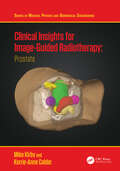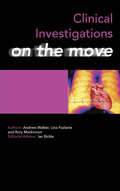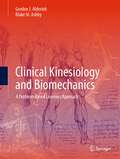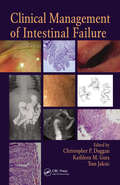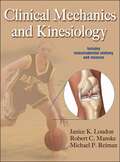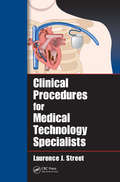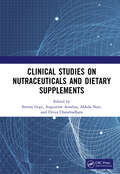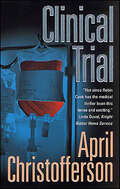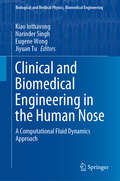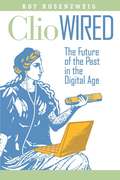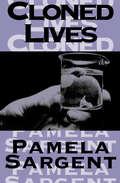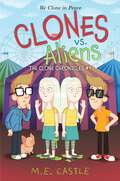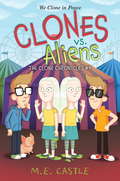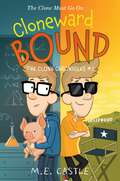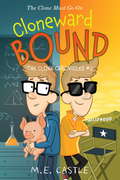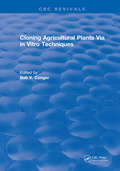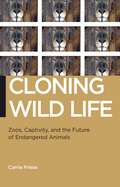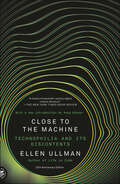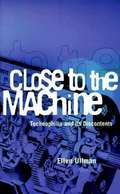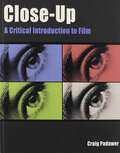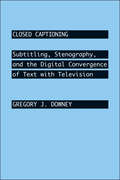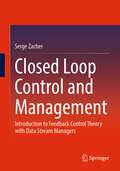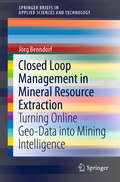- Table View
- List View
Clinical Insights for Image-Guided Radiotherapy: Prostate (ISSN)
by Mike Kirby Kerrie-Anne CalderThis book provides a clinical insight into image-guided radiation therapy (IGRT) for prostate cancer. It starts by setting the clinical scene, discussing immobilisation and standard IGRT practice and then considering important developments like IGRT with non-ionising radiation, adaptive radiotherapy, particle therapy, margins, hypofractionation, clinical outcomes, AI and training. Good IGRT requires both technical and clinical focus. So, in complement to our first study guide on IGRT, this book now brings together key, clinical insights into IGRT for Prostate Cancer patients, with a view to helping the professional learn more about ‘how-to’ undertake IGRT for these patients more accurately, effectively and safely, throughout the whole course of a patient’s treatment with radiation.This clinical insight guide will be of interest to newly qualified radiation therapists, therapeutic radiographers, medical dosimetrists, medical physicists, radiotherapy physicists and clinical oncologists. It will also be of use for trainees and can be used alongside continuing competency and clinical training within real clinical departments and radiation therapy centres worldwide.This is the first in a forthcoming series of clinical insights, each tackling a different treatment area. Further areas in the series will be: Head and Neck; Thorax; Breast; Pelvis; and the Brain.Key Features:• Internationally applicable, clinically focused, up-to-date and evidence based.· Accompanied by suitable electronic multimedia resources.· Authored by experts with decades of experience of pioneering electronic portal imaging and IGRT in clinical practice, pedagogic research and substantial experience of teaching/supervising students, trainees and qualified therapists/medical physicists at bachelors, postgraduate and doctoral levels.Mike Kirby and Kerrie-Anne Calder are well-respected authors and radiotherapy professionals, who have worked in radiotherapy physics/radiotherapy clinical and academic practice for nearly 35 years and 25 years respectively.Mike Kirby is a Senior Lecturer in Radiotherapy Physics at the University of Liverpool, UK, and an Honorary Lecturer at the University of Manchester, UK. He holds graduate and postgraduate qualifications in medical physics and has in total over 200 books, papers, oral and poster presentations to his name in the field of radiotherapy. Dr. Kirby holds professional membership of the Institute of Physics and Engineering in Medicine, the American Association of Physicists in Medicine, the American Society for Radiation Oncology, the European Society for Radiotherapy and Oncology and the British Institute of Radiology, is a Fellow of the Higher Education Academy and the British Institute of Radiology in the UK.Kerrie-Anne Calder is a Lecturer at the University of Liverpool, UK, where she educates undergraduate and post graduate students in many aspects of radiotherapy with a special interest and role in imaging training. Kerrie-Anne has graduate and postgraduate qualifications in radiotherapy, education and academic practice, is a member of the Society and College of Radiographers, and is a Fellow of the Higher Education Academy in the UK. She was a clinical and professional lead in IGRT (on-treatment verification imaging) within the NHS in the UK for over ten years.
Clinical Investigations on the Move
by Andrew Walker Rory Mackinnon Lina FazlanieThe Medicine on the Move series provides fully flexible access to subjects across the curriculum in a unique combination of print and mobile formats ideal for the busy medical student and junior doctor. No matter what your learning style, whether you are studying a subject for the first time or revisiting it during exam preparation, Medicine on the
Clinical Kinesiology and Biomechanics: A Problem-Based Learning Approach
by Gordon J. Alderink Blake M. AshbyThis new textbook uses a problem-based learning (PBL) approach for teaching the fundamentals of kinesiology and biomechanics to undergraduate and graduate students in the biomedical, rehabilitative, and exercise science fields. Case vignettes and problems for each major region of the body are presented – cervical spine, thoracic spine and rib cage, lumbar spine and pelvis, shoulder girdle, elbow/forearm, wrist, hand, hip, knee, and ankle/foot. For the cases on the spine and upper extremity, biomechanics of posture are included; for cases involving the hip, knee, and ankle/foot, an extensive study of gait analysis is also incorporated. These case vignettes are not preceded by chapters that provide foundational information. Rather, relevant anatomical, biomechanical, and other information needed to solve/explain each case are embedded in the relevant chapters presenting the clinical cases.
Clinical Management of Intestinal Failure
by Christopher P. Duggan Tom Jaksic Kathleen M. GuraA complex disease entity, intestinal failure (IF) has only recently become accepted as a distinct clinical syndrome. Improvements across a wide range of disciplines-including critical care and organ transplantation as well as surgical, medical, and nutritional therapies-have led to a steady rise in survival and quality of life for patients with IF.
Clinical Mechanics and Kinesiology
by Robert C. Manske Janice K. Loudon Michael P. ReimanClinical Mechanics and Kinesiology provides a solid foundation so that students of physical therapy, occupational therapy, and athletic training can understand biomechanics and functional anatomy as they relate to both normal and abnormal movement. Written by active clinicians with more than 40 combined years of clinical and teaching experience, this text is also a practical reference for rehabilitation professionals working with a range of populations and pathologies. Taking a clinical approach not found in other texts, Clinical Mechanics and Kinesiology follows a logical progression that maximizes learning. It first presents biomechanical principles that students must understand in order to examine and treat clients and patients undergoing rehabilitation. Next, it explores muscle and nerve physiology and function of the muscle and joint systems. Then the focus shifts to applying those concepts to specific joints. Divided into 10 regions, each joint is evaluated by the bones that make up the joints; the joint articulation, anatomy, and function; and the muscles that act on the joints. In the final section of the text, students gain insight into full-body movement patterns of particular concern to rehabilitation specialists. They will examine not only the usual topics of posture and walking gait but also running gait and the mechanics of jumping and cutting—some of the most common sources of injury.
Clinical Procedures for Medical Technology Specialists
by Laurence J. StreetAs healthcare becomes more complex, the integration of all members of the team becomes even more important. Part of this integration requires that all team members have a grasp of the fundamentals of the medical and surgical treatments they are involved in. Written specifically for paramedical professionals who support doctors and nurses, Clinical
Clinical Studies on Nutraceuticals and Dietary Supplements
by Sreeraj Gopi Augustine Amalraj Akhila Nair Divya ChandradharaThe book, Clinical Studies in Nutraceuticals and Dietary Supplements, presents extensive information on all the vital aspects and evidence-based studies on nutraceuticals and dietary supplements. The most fascinating part of this book is that the chapters explore the key concept accompanying an emphasis on recent research and developments on nutraceuticals and dietary supplements to tackle various diseases including maternal and fetal health, cancer, cardiovascular, renal disorders, hepatic disorders, hormonal disorders, and neurological dysfunction. The introspection carries updated literature reviews with relevant vital topics, quality illustrations, and well-organized tables for a better understanding of each segment. The current market scenario of these nutraceuticals and dietary supplements is the emphasis on their importance for a healthy and disease-controlled environment. This book will be useful to research scholars and scientists, as well as individuals working in the nutraceutical, dietary supplement, and functional food industries. This is an initiative to unveil the immense wealth that these nutraceuticals and dietary supplements hold and a realization of the fact that more evidence-based studies are required for its use to curb maladies and foster a healthy lifestyle.
Clinical Trial
by April ChristoffersonThe deadly hantavirus has killed hundreds of Native Americans, so when a reputable pharmaceutical company claims to have developed a vaccine against the deadly disease, it should be good news. But when ImmuVac asks Dr. Isabel McLain to conduct a clinical trial of the vaccine on the Blackfeet reservation in Browning, Montana, the proposal gets a distinctly mixed response from both her and the suspicious Blackfeet. Is the new drug truly safe, or are the Blackfeet being used as human guinea pigs?Indian activist Monty Four Bear fears the worst, but Dr. McLain stakes her reputation on the trial's safety. Having taken over the poorly-funded reservation clinic after the catastrophic failure of her marriage, Isabel has fought a long, hard struggle to gain the trust of the wary Blackfeet residents of the reservation. She knows she risks everything she's accomplished by endorsing ImmuVac's clinical trial, but she's willing to take that chance if it means developing a weapon against the hantavirus.But when corporate greed makes for questionable science, whom can Isabel truly trust with her life and her career --and the lives of the Blackfeet?At the Publisher's request, this title is being sold without Digital Rights Management Software (DRM) applied.
Clinical and Biomedical Engineering in the Human Nose: A Computational Fluid Dynamics Approach (Biological and Medical Physics, Biomedical Engineering)
by Jiyuan Tu Kiao Inthavong Narinder Singh Eugene WongThis book explores computational fluid dynamics in the context of the human nose, allowing readers to gain a better understanding of its anatomy and physiology and integrates recent advances in clinical rhinology, otolaryngology and respiratory physiology research. It focuses on advanced research topics, such as virtual surgery, AI-assisted clinical applications and therapy, as well as the latest computational modeling techniques, controversies, challenges and future directions in simulation using CFD software. Presenting perspectives and insights from computational experts and clinical specialists (ENT) combined with technical details of the computational modeling techniques from engineers, this unique reference book will give direction to and inspire future research in this emerging field.
Clio Wired: The Future of the Past in the Digital Age
by Roy RosenzweigIn these pathbreaking essays, Roy Rosenzweig charts the impact of new media on teaching, researching, preserving, presenting, and understanding history. Negotiating between the "cyberenthusiasts" who champion technological breakthroughs and the "digital skeptics" who fear the end of traditional humanistic scholarship, Rosenzweig re-envisions the practices and professional rites of academic historians while analyzing and advocating for the achievements of amateur historians. While he addresses the perils of "doing history" online, Rosenzweig eloquently identifies the promises of digital work, detailing innovative strategies for powerful searches in primary and secondary sources, the increased opportunities for dialogue and debate, and, most of all, the unprecedented access afforded by the Internet. Rosenzweig draws attention to the opening up of the historical record to new voices, the availability of documents and narratives to new audiences, and the attractions of digital technologies for new and diverse practitioners. Though he celebrates digital history's democratizing influences, Rosenzweig also argues that the future of the past in this digital age can only be ensured through the active resistance to efforts by corporations to control access and profit from the Web.
Cloned Lives
by Pamela SargentThis debut sci-fi novel by the Nebula and Locus Award–winning author of The Shore of Women follows five human clones in an unforgiving world. Shock and outrage greet Paul Swenson&’s announcement of the success of his latest and most controversial scientific endeavor. Having taken advantage of a brief lull in legislative restrictions, the renowned astrophysicist and a team of bioscientists have created five human clones—four males and one female—from Swenson&’s own genetic material. From the moment Michael, Edward, Albert, James, and Kira Swenson are revealed to the world, they are viewed with hostility and suspicion. Growing up under the heavy yoke of specialness, the five exceptional human &“experiments&” have no one but each other to turn to for emotional support. Then tragedy strikes and everything falls apart . . . Now Kira and her brothers must follow their destinies down separate, divergent paths. Heading out into a world that never welcomed them, each clone is intent on pursuing knowledge, career, family—all the desired elements of a so-called normal life. But they cannot escape their shared past, because the true purpose behind Paul Swenson&’s remarkable achievement remains shrouded in shadow. And his children are prepared to travel to the ends of the Earth and beyond for an answer to the question that has always haunted them: Why were we made?
Clones vs. Aliens (The Clone Chronicles #4)
by M. E. CastleFisher, Two, Amanda, and Veronica are happy to spend their holiday break at Fisher's parents' new amusement park. But when aliens crash-land on Fisher's favorite roller coaster, mistaking it for their home planet, it spells the end of R&R for our heroes. Meet the Gemini: not only are all the aliens identical twins, they're also all beautiful girls. The crew decides the best way to encourage the Gemini girls to vacate the stratosphere is to give them a taste of middle school. But Fisher and his crew learn quickly that the Geminis are not to be messed with, not when they might literally explode at any moment. That's right, the Geminis are like puberty times one million. They can seem sweet as pie, but when they turn on you, they're deadly.
Clones vs. Aliens: The Clone Chronicles #4
by M. E. CastleAliens join in the fun in this fourth book of The Clone Chronicles, a series that "strikes just the right balance between over-the-top adventure and real-life middle school drama," mixing Alex Rider, Diary of a Wimpy Kid, and Michael Buckley's NERD series to create an "action-packed success." Fisher, Two, Amanda, and Veronica are happy to spend their holiday break at Fisher's parents' new amusement park. But when aliens crash-land on Fisher's favorite roller coaster, mistaking it for their home planet, it spells the end of R&R for our heroes. Meet the Gemini: not only are all the aliens identical twins, they're also all beautiful girls. If Fisher and Two already thought girls were hard to understand, wait until they meet alien girls. Now Fisher, Two, Amanda, and Veronica must convince the aliens that Earth is the worst place ever and help them fix their ship. The crew decides the best way to encourage the Gemini girls to vacate the stratosphere is to give them a taste of middle school. And Wompalog Middle School tastes pretty disgusting. But Fisher and his crew learn quickly that the Geminis are not to be messed with, not when they might literally explode at any moment. That's right, the Geminis are like puberty times one million. They can seem sweet as pie, but when they turn on you, they're deadly.
Cloneward Bound (The Clone Chronicles #2)
by M. E. CastleThe second book in the hilarious middle-grade adventure series The Clone Chronicles. Fisher Bas and Two were able to thwart the evil Dr. X, but after somehow surviving the explosion at TechX Enterprises, Two is in Hollywood looking for his "mother." Fisher must bring him back to Palo Alto before his cloning secret is discovered. When a class field trip to see the Dr. Devilish science show arises, it becomes the perfect opportunity for Fisher to find his clone. But all kinds of complications will get in the way—including Amanda Cantrell, who knows more than Fisher would like about Two's identity. As Fisher, FP, and Amanda team up to find Two, they find trouble, hijinx, and the return of an evil mastermind—all set in the glitz of Hollywood.
Cloneward Bound: The Clone Chronicles #2
by M. E. CastleFisher Bas and Two were able to thwart the evil Dr. X, but after somehow surviving the explosion at TechX Enterprises, Two is in Hollywood looking for his "mother." Fisher must bring him back to Palo Alto before his cloning secret is discovered. When a class field trip to see the Dr. Devilish science show arises, it becomes the perfect opportunity for Fisher to find his clone. But all kinds of complications will get in the way--including Amanda Cantrell, who knows more than Fisher would like about Two's identity. As Fisher, FP, and Amanda team up to find Two, they find trouble, high jinx, and the return of an evil mastermind--all set in the glitz of Hollywood.
Cloning Agricultural Plants Via in Vitro Techniques
by Bob V. CongerThe purpose of this book is to provide a reference guide on principles and practices of cloning agricultural plants via in vitro techniques for scientists, students, commercial propagators, and other individuals who are interested in plant cell and tissue culture especially its application for cloning.Plant cell and tissue culture generated much excitement during 1970‘s concerning the potential application of the technology for improving important agricultural crop plants. This originates from the demonstration of cellular totipotency, or the ability to regenerate whole plants from single cells, and the successful creation of hybrids by somatic cell fusion in some species. There are several areas of in vitro culture which have potential practical application. The most practical application is deemed as cloning or mass propagation of selected genotypes. This is evidenced by the large number of commercial firms engaged in propagating a variety of plants through tissue culture.
Cloning Wild Life: Zoos, Captivity, and the Future of Endangered Animals (Biopolitics #14)
by Carrie FrieseThe natural world is marked by an ever-increasing loss of varied habitats, a growing number of species extinctions, and a full range of new kinds of dilemmas posed by global warming. At the same time, humans are also working to actively shape this natural world through contemporary bioscience and biotechnology. In Cloning Wild Life, Carrie Friese posits that cloned endangered animals in zoos sit at the apex of these two trends, as humans seek a scientific solution to environmental crisis. Often fraught with controversy, cloning technologies, Friese argues, significantly affect our conceptualizations of and engagements with wildlife and nature.By studying animals at different locations, Friese explores the human practices surrounding the cloning of endangered animals. She visits zoos—the San Diego Zoological Park, the Audubon Center in New Orleans, and the Zoological Society of London—to see cloning and related practices in action, as well as attending academic and medical conferences and interviewing scientists, conservationists, and zookeepers involved in cloning. Ultimately, she concludes that the act of recalibrating nature through science is what most disturbs us about cloning animals in captivity, revealing that debates over cloning become, in the end, a site of political struggle between different human groups. Moreover, Friese explores the implications of the social role that animals at the zoo play in the first place—how they are viewed, consumed, and used by humans for our own needs. A unique study uniting sociology and the study of science and technology, Cloning Wild Life demonstrates just how much bioscience reproduces and changes our ideas about the meaning of life itself.
Close to the Machine: Technophilia and Its Discontents
by Ellen UllmanWith a New Introduction by Jaron Lanier A Salon Best Book of the Year In 1997, the computer was still a relatively new tool---a sleek and unforgiving machine that was beyond the grasp of most users. With intimate and unflinching detail, software engineer Ellen Ullman examines the strange ecstasy of being at the forefront of the predominantly male technological revolution, and the difficulty of translating the inherent messiness of human life into artful and efficient code. Close to the Machine is an elegant and revelatory mediation on the dawn of the digital era.
Close to the Machine: Technophilia and its Discontents
by Ellen UllmanA candid account of the life of a software engineer who runs her own computer consulting business in San Francisco. What is it about the numerical, seemingly inhuman world of computing that holds such powerful, wholly human allure?
Close-Up: A Critical Introduction to Film
by Craig PadawerClose-Up: A Critical Introduction to Film 1st Edition
Closed Captioning: Subtitling, Stenography, and the Digital Convergence of Text with Television (Johns Hopkins Studies in the History of Technology)
by Gregory J. DowneyThis engaging study traces the development of closed captioning—a field that emerged in the 1970s and 1980s from decades-long developments in cinematic subtitling, courtroom stenography, and education for the deaf. Gregory J. Downey discusses how digital computers, coupled with human mental and physical skills, made live television captioning possible. Downey's survey includess the hidden information workers who mediate between live audiovisual action and the production of visual track and written records. His work examines communication technology, human geography, and the place of labor in a technologically complex and spatially fragmented world. Illustrating the ways in which technological development grows out of government regulation, education innovation, professional profit-seeking, and social activism, this interdisciplinary study combines insights from several fields, among them the history of technology, human geography, mass communication, and information studies.
Closed Loop Control and Management: Introduction to Feedback Control Theory with Data Stream Managers
by Serge ZacherThe block diagrams as engineering means for closed loop control, which have been established by classic control theory for decades, are replaced in the above mentioned book by networks, the signals are replaced by data. It corresponds to the „Industry 4.0“ and to the structure of today’s automatic control systems. Thereby a classic closed loop is treated not isolated from other elements of nowadays automation like bus communication and process logical control, and is completed in proposed book with new control elements, so called data stream managers (DSM). The proposed book treats the control theory systematically like it is done in classical books considering the new concept of data management. The theory is accompanied in the book with examples, exercises with solutions and MATLAB®-simulations.
Closed Loop Management in Mineral Resource Extraction: Turning Online Geo-Data into Mining Intelligence (SpringerBriefs in Applied Sciences and Technology)
by Jörg BenndorfThis book describes an innovative closed-loop concept that allows the feedback of online data from operational monitoring to create mining intelligence. The application of this concept promises significant improvements in economic and environmental key performance indicators for any mining operation.Combining theory with industrial case studies, the book guides readers through this process by providing theoretical background, addressing practical issues related to operational implementation, and illustrating the impact on selected examples. This new concept is presented using the example of a bulk and gold mining application, but is applicable at any mine where grade control is important.The book is of interest to industrial professionals involved in operational monitoring, mining intelligence, and mine planning optimization, as well as to researchers and academics in the field of applied geostatistics.
Closed Power Cycles: Thermodynamic Fundamentals and Applications (Lecture Notes in Energy #11)
by Costante Mario InvernizziWith the growing attention to the exploitation of renewable energies and heat recovery from industrial processes, the traditional steam and gas cycles are showing themselves often inadequate. The inadequacy is due to the great assortment of the required sizes power and of the large kind of heat sources. Closed Power Cycles: Thermodynamic Fundamentals and Applications offers an organized discussion about the strong interaction between working fluids, the thermodynamic behavior of the cycle using them and the technological design aspects of the machines. A precise treatment of thermal engines operating in accordance with closed cycles is provided to develop ideas and discussions strictly founded on the basic thermodynamic facts that control the closed cycles operation and design. Closed Power Cycles: Thermodynamic Fundamentals and Applications also contains numerous examples which have been carried out with the help of the Aspen Plus®R program. Including chapters on binary cycles, the organic Rankine cycle and real closed gas cycles, Closed Power Cycles: Thermodynamic Fundamentals and Applications acts a solid introduction and reference for post-graduate students and researchers working in applied thermodynamics and energy conversion with thermodynamic engines.
Closed-Loop Supply Chains: New Developments to Improve the Sustainability of Business Practices (Supply Chain Integration Modeling, Optimization and Application)
by Mark E. Ferguson Gilvan C. SouzaClosed-loop supply chain activities such as remanufacturing, recycling, dismantling for spare parts, and reverse logistics have helped many companies tap into new revenue streams by finding secondary markets for their products, all while reducing their overall carbon footprint. Written by academic experts, in language that is accessible to practitioners, this authoritative resource examines recent research and case studies of companies running profitable reuse/remanufacture operations in various industries. It illustrates profitable practices in returned and recovered products, clearly explaining how to: design a reverse logistics network, conduct production planning, implement effective marketing strategies, and apply closed-loop supply chain strategies in industries besides manufacturing. From product development to materials to assembly and profitability, this complete resource explores the impact of these processes across all aspects of the supply chain.
